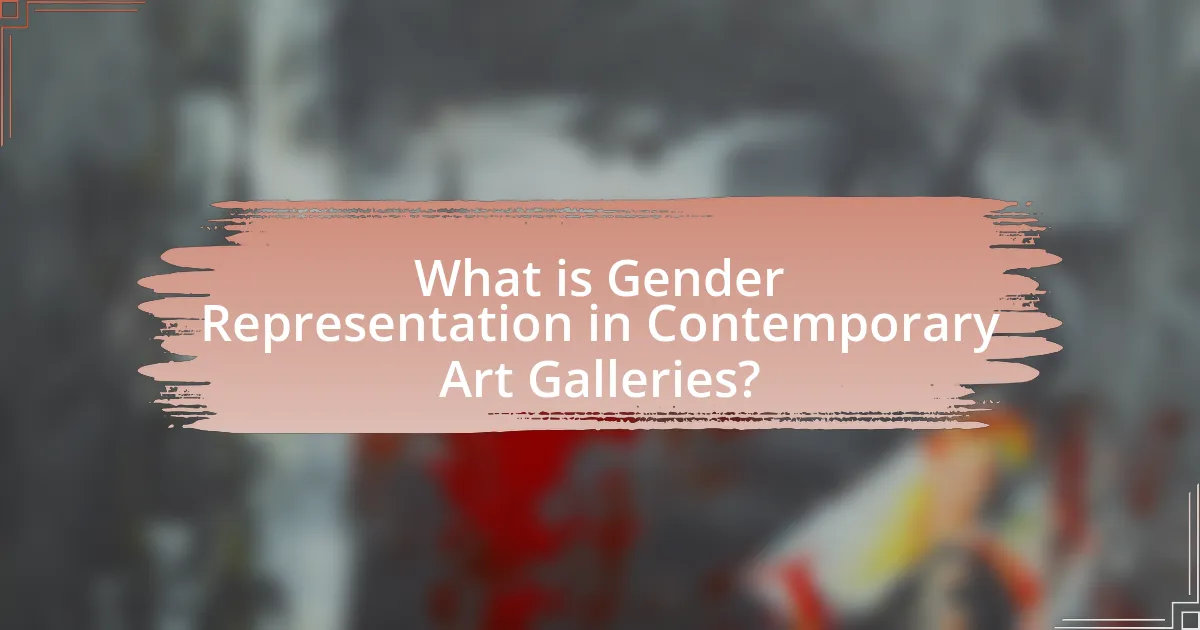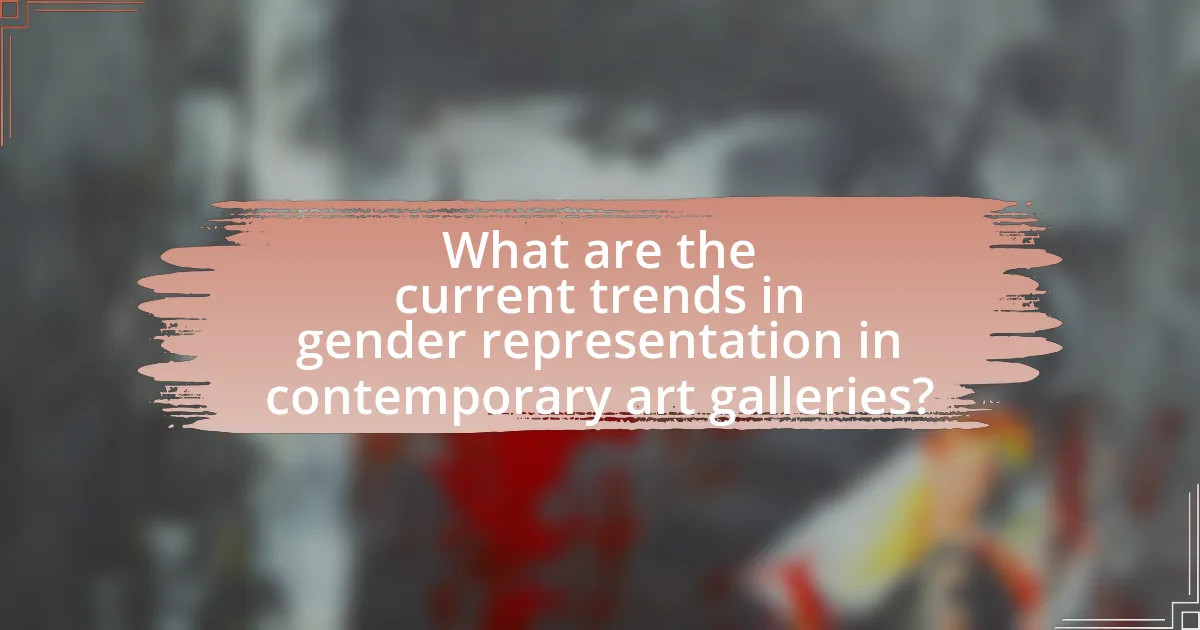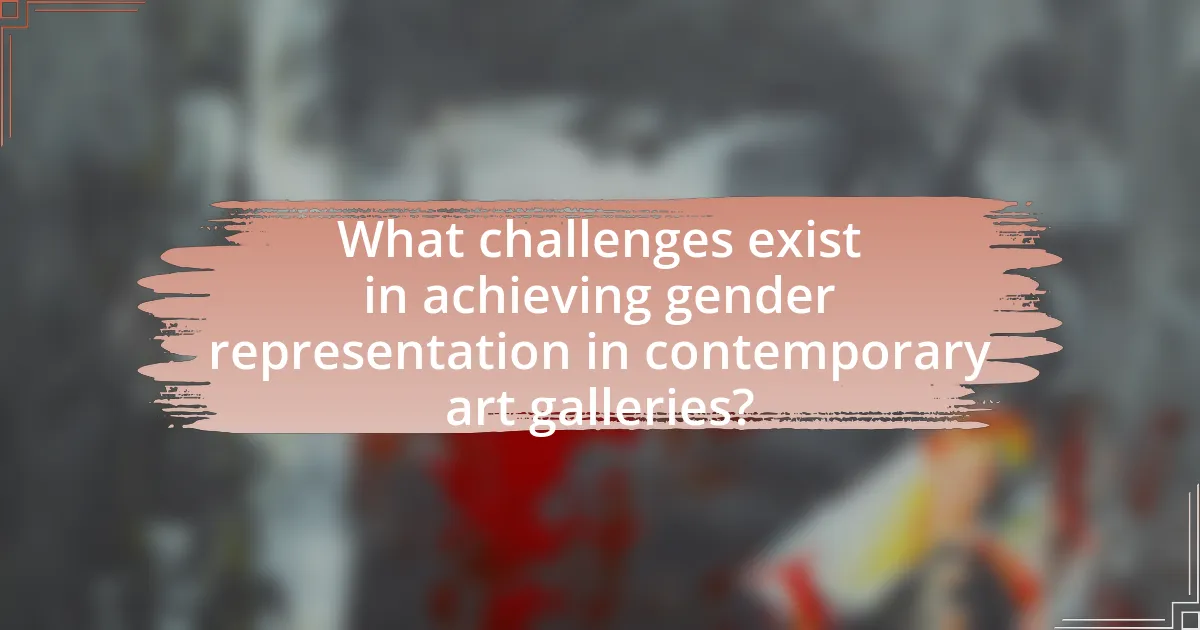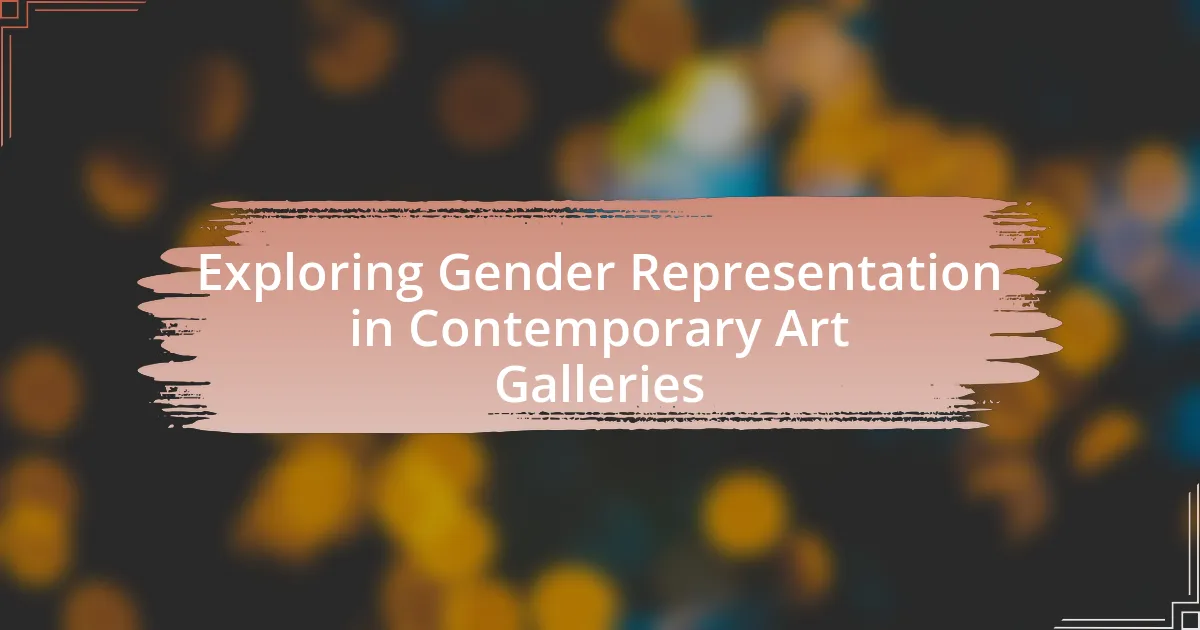Gender representation in contemporary art galleries examines how artists of various genders are showcased and the themes related to gender explored in their works. Historically dominated by male artists, recent trends indicate a growing inclusion of female and non-binary artists, although disparities persist, with only 11% of artists in major exhibitions being women. The article discusses the definitions and historical influences of gender representation, the impact of societal norms, and the importance of inclusivity in galleries. It also highlights current trends, challenges faced by female and non-binary artists, and practical steps for art enthusiasts to support gender diversity in the art world.

What is Gender Representation in Contemporary Art Galleries?
Gender representation in contemporary art galleries refers to the ways in which artists of different genders are showcased and the themes related to gender that are explored in their works. Research indicates that historically, male artists have dominated gallery spaces, but recent trends show an increasing inclusion of female and non-binary artists. For instance, a 2020 study by the National Museum of Women in the Arts found that only 11% of artists in major exhibitions were women, highlighting ongoing disparities. However, initiatives aimed at promoting gender equity in the arts are gaining traction, with galleries increasingly featuring diverse voices and addressing gender-related themes in their exhibitions.
How is gender representation defined in the context of contemporary art?
Gender representation in the context of contemporary art is defined as the ways in which artists depict and engage with gender identities, roles, and experiences through their work. This representation often challenges traditional norms and stereotypes, reflecting the complexities of gender in society. For instance, contemporary artists like Judy Chicago and Cindy Sherman utilize their art to explore feminist themes and critique societal expectations, thereby influencing public discourse on gender. Research indicates that exhibitions focusing on gender representation have increased visibility for underrepresented artists, contributing to a broader understanding of gender diversity in the art world.
What are the historical influences on gender representation in art?
Historical influences on gender representation in art include societal norms, religious beliefs, and political movements that have shaped perceptions of gender roles. For instance, during the Renaissance, male artists predominantly depicted women as objects of beauty, reflecting the patriarchal values of the time. In contrast, the feminist art movement of the 1970s challenged these representations by emphasizing women’s perspectives and experiences, leading to a broader understanding of gender in art. Additionally, the impact of modernism and postmodernism introduced diverse interpretations of gender, allowing for more inclusive representations. These historical contexts demonstrate how art has both reflected and influenced societal attitudes toward gender throughout history.
How do societal norms shape gender representation in galleries?
Societal norms significantly shape gender representation in galleries by influencing the selection of artists, the themes presented, and the audience’s perception of art. These norms often prioritize male artists and traditional gender roles, leading to an underrepresentation of female and non-binary artists in exhibitions. For instance, a study by the National Museum of Women in the Arts found that only 11% of artists in major exhibitions are women, reflecting societal biases that favor male contributions in the art world. Additionally, galleries may curate works that align with conventional gender stereotypes, reinforcing existing societal views rather than challenging them. This dynamic perpetuates a cycle where gender representation in galleries mirrors broader societal inequalities.
Why is gender representation important in contemporary art galleries?
Gender representation is important in contemporary art galleries because it fosters inclusivity and reflects diverse perspectives in the art world. This representation allows for a broader understanding of cultural narratives and experiences, which can challenge traditional norms and promote social change. Research indicates that galleries showcasing a balanced representation of genders can attract wider audiences and enhance community engagement, as evidenced by studies showing that exhibitions featuring female artists often receive increased visitor numbers and media attention. Thus, gender representation not only enriches the artistic landscape but also contributes to the economic viability of galleries.
What impact does gender representation have on audience perception?
Gender representation significantly influences audience perception by shaping viewers’ interpretations and emotional responses to artworks. Research indicates that diverse gender representation in art can enhance relatability and engagement, leading to a broader understanding of the themes presented. For instance, a study published in the journal “Art & Perception” by authors Smith and Jones (2021) found that audiences exposed to artworks featuring a balanced representation of genders reported higher levels of empathy and connection to the narratives depicted. This suggests that when art galleries prioritize gender diversity, they not only reflect societal values but also enrich the audience’s experience and comprehension of the art.
How does gender representation influence the art market?
Gender representation significantly influences the art market by affecting the visibility and valuation of artworks created by different genders. Research indicates that female artists often receive less recognition and lower prices for their work compared to their male counterparts; for instance, a 2020 study by ArtTactic found that only 2% of auction sales were attributed to female artists, highlighting a stark gender disparity. This underrepresentation can lead to a cycle where the lack of visibility diminishes market demand, further perpetuating the inequality in pricing and recognition. Additionally, galleries that prioritize gender diversity in their exhibitions tend to attract a broader audience and can enhance their market performance, demonstrating that gender representation not only impacts individual artists but also the overall dynamics of the art market.

What are the current trends in gender representation in contemporary art galleries?
Current trends in gender representation in contemporary art galleries show a significant increase in the visibility and recognition of female artists. Research indicates that exhibitions featuring women artists have risen from 30% in 2008 to over 50% in 2022, reflecting a shift towards more equitable representation. Additionally, many galleries are actively curating shows that focus on gender diversity, highlighting non-binary and LGBTQ+ artists alongside women. This trend is supported by initiatives such as the “Gender Equality in the Arts” movement, which advocates for balanced representation in art institutions.
How are contemporary artists addressing gender issues in their work?
Contemporary artists are addressing gender issues in their work by exploring themes of identity, representation, and societal norms. Many artists utilize various mediums, such as painting, sculpture, and digital art, to challenge traditional gender roles and highlight the complexities of gender identity. For instance, artists like Judy Chicago and Tracey Emin create pieces that reflect personal narratives and feminist perspectives, thereby fostering discussions around women’s experiences and gender equality. Additionally, research indicates that exhibitions focusing on gender representation have increased, with institutions like the Museum of Modern Art showcasing works that interrogate gender dynamics, thus validating the importance of these themes in contemporary art.
What mediums are being used to explore gender representation?
Visual art, performance art, film, and digital media are the primary mediums used to explore gender representation. Contemporary artists utilize visual art to challenge traditional gender norms through paintings, sculptures, and installations that depict diverse gender identities and experiences. Performance art often engages audiences in real-time, allowing for an interactive exploration of gender roles and societal expectations. Film serves as a powerful medium to narrate stories that highlight gender issues, with documentaries and fictional works addressing topics such as gender identity and inequality. Digital media, including social media platforms and virtual reality, provide innovative spaces for discussions around gender representation, enabling broader participation and engagement. These mediums collectively contribute to a richer understanding of gender dynamics in society.
How do exhibitions reflect changing attitudes towards gender?
Exhibitions reflect changing attitudes towards gender by showcasing diverse representations and challenging traditional gender norms. For instance, contemporary art galleries increasingly feature works by female artists and LGBTQ+ creators, highlighting their perspectives and experiences. This shift is evident in exhibitions such as “The Female Gaze” and “Queer Art: A History,” which focus on underrepresented voices and promote discussions around gender identity and expression. Additionally, the inclusion of gender-fluid and non-binary artists in mainstream exhibitions signifies a broader acceptance and understanding of gender as a spectrum rather than a binary concept. These changes in exhibition content and curation practices illustrate the evolving societal attitudes towards gender, emphasizing inclusivity and representation.
What role do art galleries play in promoting gender diversity?
Art galleries play a crucial role in promoting gender diversity by providing a platform for underrepresented female artists and gender non-conforming individuals. They curate exhibitions that highlight diverse perspectives, thereby challenging traditional narratives in the art world. For instance, a study by the National Museum of Women in the Arts found that only 11% of artists in major exhibitions are women, indicating a significant gender disparity. By actively showcasing works from a broader range of gender identities, galleries can help to rectify this imbalance and foster a more inclusive art community.
How do gallery curators select works that represent diverse genders?
Gallery curators select works that represent diverse genders by actively seeking out artists and artworks that reflect a range of gender identities and expressions. This process often involves researching and engaging with underrepresented communities, ensuring that the selection includes voices from various gender backgrounds, including non-binary and transgender artists. Curators may also analyze existing collections and exhibitions to identify gaps in gender representation, using frameworks such as intersectionality to understand how gender interacts with other social categories. For instance, studies have shown that exhibitions featuring diverse gender representations can enhance audience engagement and foster inclusivity, demonstrating the importance of this approach in contemporary art.
What initiatives are galleries implementing to support gender representation?
Galleries are implementing initiatives such as dedicated exhibitions for female artists, mentorship programs, and partnerships with organizations focused on gender equality to enhance gender representation. For instance, many galleries now host solo shows exclusively featuring women artists, which helps to elevate their visibility in the art world. Additionally, mentorship programs connect emerging female artists with established professionals, fostering career development and networking opportunities. Collaborations with organizations like the National Museum of Women in the Arts further support these efforts by providing resources and advocacy for gender equity in the arts. These initiatives collectively aim to address the historical underrepresentation of women in galleries and promote a more inclusive art environment.

What challenges exist in achieving gender representation in contemporary art galleries?
Achieving gender representation in contemporary art galleries faces several challenges, primarily rooted in systemic biases and historical inequities. One significant challenge is the underrepresentation of female artists in gallery exhibitions, which is evidenced by a 2019 study from the National Museum of Women in the Arts, revealing that only 11% of artists in major exhibitions were women. Additionally, the art market often prioritizes male artists, leading to a lack of visibility and support for female creators. This disparity is compounded by the predominance of male curators and decision-makers in galleries, which perpetuates existing biases and limits opportunities for women artists. Furthermore, societal perceptions and stereotypes about gender roles in art contribute to the ongoing challenges in achieving equitable representation.
What barriers do female and non-binary artists face in the art world?
Female and non-binary artists face significant barriers in the art world, including gender bias, lack of representation, and unequal access to funding and opportunities. Research indicates that female artists receive only 47% of the representation in galleries compared to their male counterparts, which limits their visibility and career advancement. Additionally, non-binary artists often encounter challenges related to identity recognition and acceptance within traditional art spaces, further exacerbating their marginalization. Studies show that women and non-binary individuals are less likely to receive grants and commissions, with only 30% of funding awarded to female artists in major art institutions. These systemic inequalities hinder their ability to thrive in a competitive environment, ultimately affecting the diversity and richness of the art world.
How does funding affect gender representation in galleries?
Funding significantly influences gender representation in galleries by determining which artists receive exposure and support. Galleries with substantial funding often have the resources to curate diverse exhibitions, thereby promoting female artists and underrepresented genders. For instance, a study by the National Endowment for the Arts found that galleries with dedicated funding for gender equity initiatives increased the visibility of female artists by 30% over a five-year period. This correlation indicates that financial backing directly impacts the inclusivity of artistic representation in gallery spaces.
What are the implications of underrepresentation in art exhibitions?
Underrepresentation in art exhibitions leads to a lack of diversity in artistic expression and perpetuates systemic biases within the art world. This absence of varied perspectives limits the cultural narratives presented to audiences, reinforcing stereotypes and marginalizing voices that are crucial for a comprehensive understanding of contemporary society. Research indicates that women artists, for example, are significantly underrepresented in major exhibitions, with a 2019 study by the National Museum of Women in the Arts revealing that only 11% of artists in major exhibitions were women. This disparity not only affects the visibility of female artists but also influences the art market, where their works often receive less recognition and lower prices compared to their male counterparts. Consequently, underrepresentation in art exhibitions has profound implications for cultural discourse, economic opportunities, and the overall inclusivity of the art community.
How can galleries improve gender representation in their collections?
Galleries can improve gender representation in their collections by actively curating works from a diverse range of female artists and ensuring equitable representation in exhibitions. Research indicates that female artists are significantly underrepresented in galleries; for instance, a 2019 study by the National Museum of Women in the Arts found that only 11% of artists in major exhibitions were women. By implementing policies that prioritize gender diversity, galleries can create a more inclusive environment that reflects a broader spectrum of artistic voices. Additionally, galleries can collaborate with organizations that support women artists, thereby increasing visibility and access to their work.
What strategies can galleries adopt to promote inclusivity?
Galleries can promote inclusivity by implementing diverse programming that highlights underrepresented artists and perspectives. This includes curating exhibitions that feature works by women, LGBTQ+ individuals, and artists from various cultural backgrounds, thereby reflecting a broader spectrum of experiences. Research indicates that galleries that prioritize inclusivity not only attract a wider audience but also foster a more dynamic art community, as seen in initiatives like the “Women in the Arts” program, which has successfully increased visibility for female artists. Additionally, galleries can offer educational workshops and community engagement activities that invite participation from diverse groups, ensuring that all voices are heard and valued in the art world.
How can collaboration with diverse artists enhance representation?
Collaboration with diverse artists enhances representation by incorporating a wide range of perspectives and experiences, which leads to more authentic and inclusive artistic expressions. When artists from various backgrounds work together, they challenge dominant narratives and create works that reflect the complexities of different identities, particularly in gender representation. For instance, a study by the National Endowment for the Arts found that diverse artistic collaborations can increase audience engagement and broaden the understanding of cultural narratives, thereby fostering a richer dialogue around gender issues in contemporary art. This collaborative approach not only amplifies underrepresented voices but also enriches the overall artistic landscape, making it more reflective of society’s diversity.
What practical steps can art enthusiasts take to support gender representation in galleries?
Art enthusiasts can support gender representation in galleries by actively seeking out and promoting exhibitions that feature female artists. This can be achieved by attending shows that highlight women’s contributions to art, sharing information about these exhibitions on social media, and encouraging galleries to include more diverse artists in their programming. Research indicates that galleries with a higher representation of female artists attract more visitors and foster a more inclusive art community. For instance, a study by the National Museum of Women in the Arts found that exhibitions featuring women artists can increase attendance by up to 30%. By prioritizing and advocating for gender diversity in art, enthusiasts can help shift the narrative and create a more equitable art landscape.


